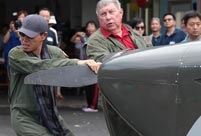


A truck transports containers at a port in Qingdao, East China's Shandong Province, on August 8.
"Raping." "Killing." "Slitty-eyed."
These are some comments made by top politicians in the US and the EU - China's two largest trading partners - about Chinese exports and trade officials. In the US, China is "raping" and "killing" the US on trade with cheap products that benefited from a deliberately devalued currency, its trade-bashing populist President-elect Donald Trump has said. In the EU, "slitty-eyed" Chinese trade officials are determining international trade rules, while the EU is failing to negotiate free trade deals, suggested Guenther Oettinger, a center-right politician from Germany who was named to become the EU's next budget commissioner.
A little extreme? Perhaps. But such sentiment against China, which is growing at a horrifying speed in some countries, indeed reflected, to some extent, the tough trading environment the world's largest trading country experienced in 2016.
It was a year of rising challenges on trade, amid an unprecedented wave of anti-free trade, anti-globalization sentiment that flowed through traditionally pro-free trade countries and regions like the US and the EU, Chinese experts said.
Rising challenges
As of Monday, there had been more than 260 anti-dumping measures or investigations against Chinese goods this year from countries and regions on all continents and at different levels of economic development, from South America to Africa and from the US to Argentina, the Global Times found in counting statements from the Ministry of Commerce (MOFCOM). This year's number represents a roughly 17.7 percent rise from 2015.
By country, more than 40 of the protectionist measures or investigations in 2016 were taken by the US and the EU, while emerging economies like India, Brazil and South Africa took more than 70 anti-dumping measures or investigations against Chinese exports.
The measures or probes were aimed at a wide range of Chinese goods, from agricultural products to tires to solar photovoltaic systems. But Chinese steel products were the target of the most anti-dumping measures or probes in 2016.
Claiming Chinese manufacturers are selling steel into Europe at unfairly low prices, the EU has launched a slew of anti-dumping and anti-subsidy measures against Chinese steel imports. As of December 9, the EU had 40 such measures in place, and almost half of them involved imports from China, according to Reuters.
In October, the EU slapped tariffs of up to 73.7 percent on Chinese steel imports. And in the US, new tariffs of as high as 266 percent were imposed this year on steel imports from China, the Wall Street Journal reported on December 8. Such measures led to a year-on-year drop of 16 percent in China's steel exports in November, according to the Wall Street Journal report.
Chinese officials and industry experts have vigorously pushed back claims that the country is dumping its steel production and blasted the EU and the US for taking such unfair measures against Chinese products.
Easy target
"All these countries like to blame China for their own problems in the steel industry, but China didn't create the problems for them, it's sluggish global demand amid weak economic growth that caused the problem," said Jiang Yong, a research fellow at the China Institutes of Contemporary International Relations.
Global trade is in the doldrums and a lot of countries are facing tough economic times at home, with unemployment rising and wages stagnating, Jiang told the Global Times on Sunday. "When things are not going well, it is easy to point fingers at others, and that is what they are doing - pointing fingers at China," he said.
It's not just the steel industry. China is an easy target for trade criticism for foreign politicians in many other areas as well, mostly because of China's position as the largest trading nation, according to Sang Baichuan, director of the Beijing-based Institute of International Business at the University of International Business and Economics.
"Tall trees catch the wind," Sang told the Global Times on Sunday. "As the world's largest trading nation, the leading exporter of more than 220 products and top trading partner for more than 100 countries and regions, China is an easy target for many countries in trade competition."
While 2016 is one of the toughest China has experienced, receiving more trade remedy measures from more countries, that's not all, experts said. They noted that China also faced broader challenges in its foreign trade, with a number of countries and regions like the US, Japan and the EU refusing to stop using a "surrogate price reference mechanism" under the WTO.
Under a provision in the Protocol on China's accession to the WTO in 2001, other WTO members were allowed to use a "surrogate country" method in anti-dumping investigations into Chinese imports, but that provision was set to expire after 15 years "in any event."
The provision expired on December 11, 2016.
But the US, Japan and the EU did not drop the "surrogate" mechanism and fulfill their WTO obligations, according to the MOFCOM. The three have refused to recognize China as a market economy, which, according to experts, is a move they took to leave the door open for future anti-dumping measures.
The MOFCOM on December 12 took legal action under the WTO's dispute settlement mechanism and vowed to vigorously protect China's interests. Although the WTO is likely to rule in favor of China, the process might take some time, experts said, which means China has a long fight ahead.
Even under a barrage of trade protectionist measures and a worsening global trade environment, Chinese trade data showed upbeat signs in November, with exports in dollar terms expanding 0.1 percent on-year, reversing a 7.3 percent decline in October, and imports rising 6.7 percent, according to data from the General Administration of Customs (GAC) released on December 8. The trade surplus was $44.61 billion in the month, down from October's $49.06 billion, the GAC data showed.
In addition, this year has offered China a chance to be the leader in the fight against anti-free trade and anti-globalization sentiment, with more countries turning to China for regional free trade agreements, experts noted. They pointed to China's roles in hosting this year's G20 Summit and in the APEC Summit in Lima, Peru, where on both occasions Chinese President Xi Jinping voiced China's commitment to global trade.
Tougher year ahead
But this is no time to celebrate, and an even tougher year might lie ahead for China in trade, Wang Jun, deputy director of the Department of Information at the China Center for International Economic Exchanges, told the Global Times on Sunday.
"Foreign trade did show some positive signs in the second half of the year, supported mostly by slight improvements in global demand and the steep depreciation of the yuan against the US dollar," Wang said.
But the improvements won't be sustained and the yuan is unlikely to depreciate at this year's pace, because the dollar might peak and depreciate next year, according to Wang.
Adding to the dim outlook is a global wave of anti-free trade, anti-globalization sentiment, mirrored in the US election of Donald Trump and the UK's decision to leave the EU.
"The fight will go on," Sang said. He noted China needs to prepare for another year of rising trade challenges.
While China is on the defensive when it comes to foreign governments' anti-dumping measures, China could, in some cases, respond with similar measures on their products, said Sang.
However, the best way forward is for China to continue to engage in regional free trade deals such as the Regional Comprehensive Economic Partnership and Free Trade Area of the Asia-Pacific and continue to carry out its "Belt and Road" initiative, he said.
 Top 10 Chinese tech and engineering marvels
Top 10 Chinese tech and engineering marvels Tom Cruise in Palace Museum
Tom Cruise in Palace Museum Home-made plane completes test flight in Chicago
Home-made plane completes test flight in Chicago The untold stories of women in the Long March
The untold stories of women in the Long March Female soldiers on Frigate Jingzhou
Female soldiers on Frigate Jingzhou Top 10 most beautiful Chinese athletes in Rio
Top 10 most beautiful Chinese athletes in Rio Shenzhen seizes 549 tons of illegally smuggled clothing
Shenzhen seizes 549 tons of illegally smuggled clothing Chinese actor Wang Baoqiang divorces wife, fires manager
Chinese actor Wang Baoqiang divorces wife, fires manager Hangzhou: host city of G20 Summit
Hangzhou: host city of G20 SummitChina claims to have a working version of NASA's impossible…
Op-Ed: Underwater drone just a sample of US military action…
China claims legitimacy of defensive facilities on South Ch…
Manufacturing tycoon's investment in U.S. sparkes debate ov…
India should be cautious in rebuilding special forces in bo…
 Top 10 livable Chinese cities
Top 10 livable Chinese cities 10 Chinese cities with most beautiful night view
10 Chinese cities with most beautiful night view Top 10 summer resorts in China
Top 10 summer resorts in China Top 10 most competitive Chinese cities
Top 10 most competitive Chinese cities Single and lovin’ it!
Single and lovin’ it!
 Sao Tome cuts ties and tolls bell for Taiwan ‘diplomacy’
Sao Tome cuts ties and tolls bell for Taiwan ‘diplomacy’
 Beijing’s network of defense tunnels become cheap homes, maze for thrill-seekers
Beijing’s network of defense tunnels become cheap homes, maze for thrill-seekers
 Decline in intl adoptions due to growing domestic demand, less abandonment
Decline in intl adoptions due to growing domestic demand, less abandonment